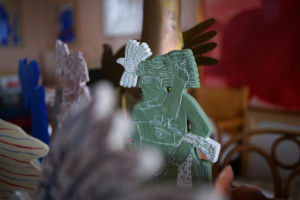In a quiet, leafy street in Papagou, a three-storey house, which doubled as Alekos Fassianos’ studio, occupies one end of the street. Wafts of freshly baked tsoureki drift from the bakery just across. There is little to prepare you before you enter the home of an icon.
And then you notice the details: the whimsical sun and moon metalwork that frame the windows, mosaics with the official Xaire (welcome) and informal Ela (come) on the threshold to the public and private spaces of the home respectively, sculpted leaves that grace the banisters, gently curving walls without corners designed to avoid a harsh coming-together. Paintings, lithographs, tiles, ceramics, ceiling canopies and tapestries line the walls in a colour-soaked collage of artifacts and paintings. Rolls of posters from exhibitions past are stacked in different corners and there are piles and piles of lithographs everywhere alluding to the prolific productivity and creative versatility of the artist, even in his later years when his health had begun to fail him.

Inside, terrazzo floors in muted shades and bright white walls draw the eye to earth- toned constellations of art and handmade ceramics. The house is eclectic and chic. Rich with hues of mustard, cherry, and clay, the house is as inviting for its poetic interior as it is for its immaculately kept garden. The terrace floor – in a mind-bending visual illusion of black and white checkerboard tiles – is interspersed with sun and moon motifs – that amp up the drama of Mt. Hymettus’ pine-clad slopes beyond. Details abound – even mundane, potential eyesores like chimney tops to drain pipes are elevated to works of art, populated with doves and bees.
Fassianos’ daughter Viktoria and wife Mariza continue to live in the house but have left everything in situ since the artist’s passing earlier this year. “Every detail was painstakingly crafted by him, by hand, little by little, like a small paradise,” Viktoria added, drawing attention to the light fixtures, the door handles, the armchairs and ottomans, curtain rods, the stairwell.

Some of the works will find a new, permanent home in the museum designed by his dear friend, the late architect Kyriakos Krokos. The museum will rekindle interest in the rundown district around Larissis station. Housed in an unremarkable building from the ‘70s, at the intersection of Metaxa and Chiou streets, Fassianos had solicited the help of his architect friend to recreate the space with his own sense of aesthetics. The new museum, to open in autumn 2022, will showcase Fassianos’ singular anthropo- centric style; a ‘veritable visual treatise on everyday life.’
Despite spending a considerable part of his career abroad, Fassianos’ paintings have a distinctly Greek identity. “The concept of Greekness is central to my father’s work,” says Viktoria Fassianou. “Even living abroad, he focused on his core identity as an Athenian.”

His works are anchored in Greek symbolism – from bees and fish to round waves evoking Homer’s “Odyssey” and other scenes drawn from Byzantine art and mythology. Even the vivid pops of lapis lazuli blue and vermil- lion – convey Greece’s cloudless blue skies and dry summer heat. The ochre reflects the inspiration of traditional Greek handcrafts. “Growing up I never realized it was an exceptional house,” says Fassianou. “But watching people’s reactions as they visit, I realized how special it is.”
The Alekos Fassianos Museum is located at the corner of Metaxa and Chiou Streets, Larissis Station, 10437 Athens. It will open to the public in autumn 2022 and will host exhibitions and educational programmes throughout the year.
Article written by Sudha Eliades.
